![]()
![]()
![]()
Use LEFT and RIGHT arrow keys to navigate between flashcards;
Use UP and DOWN arrow keys to flip the card;
H to show hint;
A reads text to speech;
122 Cards in this Set
- Front
- Back
- 3rd side (hint)
|
Stimulus
|
Any change in an environment that causes a response e.g. External (temp, pH) and internal (blood glucose)
|
|
|
|
Response
|
A change in behaviour or physiology as a result of a change in the environment e.g. Sweating/shivering
|
|
|
|
Homeostatsis
|
The maintenance of a constant internal environment despite external changes
|
|
|
|
Negative feedback
|
A mechanism that brings about any reversal of any change in conditions. It ensures that an optimum is maintained and that any change is brought back to the optimum e.g. Insulin secretion
|
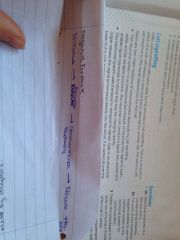
|
|
|
Positive feedback
|
A process that amplifies and increases any change detected by receptors e.g. Oxytocin in child birth
|
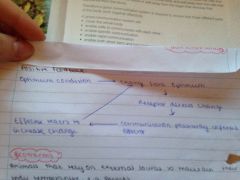
|
|
|
Two major cell signalling systems are:
|
1. Endocrine (hormone)
2. Nervous |
|
|
|
Negative feedback
|
A mechanism that brings about any reversal of any change in conditions. It ensures that an optimum is maintained and that any change is brought back to the optimum e.g. Insulin secretion
|
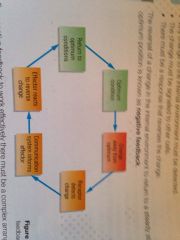
|
|
|
Positive feedback
|
A process that amplifies and increases any change detected by receptors e.g. Oxytocin in child birth
|
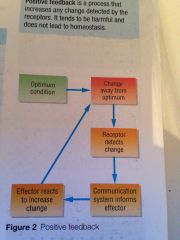
|
|
|
Two major cell signalling systems are:
|
1. Endocrine (hormone)
2. Nervous |
|
|
|
Ectotherm
|
Organisms that rely on external sources in order to maintain their body temperature e.g. Snake
|
|
|
|
Advantages of ectotherms
|
•survive in a range of temperatures
•can live in areas with unreliable food source •more energy used for growth |
|
|
|
A good communication system will:
|
•long and short term responses
•communication pathway •quick •cover the whole body •allow cells to communicate with each other •enable specific communication |
|
|
|
Disadvantages of ectotherms
|
•inactive at extremes of temperature
•susceptible to predation •vulnerable to temperature changes Can't survive in extreme conditions |
|
|
|
Endotherm
|
Organisms which can maintain their internal body temperatures despite external changes
|
|
|
|
Advantages of endotherms
|
•remain active all year
•body temperature remains constant •can inhabit areas with more extreme temperatures •less vulnerable to extreme temperature changes |
|
|
|
Disadvantages of endotherms
|
•less energy for growth
•have to eat more food |
|
|
|
Adaptations of ectotherms
|
•Expose body to sun- absorb more heat energy and warm up e.g. Snake
•Orientate body towards sun- larger surface area exposed absorb more energy e.g. Locust •Orientate body away from sun- smaller surface area exposed absorb more less energy e.g. Locust •Hide in burrows- out if sunlight and cool down e.g. Lizards •Alter body shape- increase/decrease surface area exposed e.g. Horned lizard •Increase breathing area- cool down as evaporate more e.g. Locusts |
|
|
|
Physiological adaptations of endotherms if core temperature too high
|
•Sweat glands- sweat is secreted on to skin, water from sweat evaporates and heat from blood used to supply specific latent heat if vaporisation
•Lungs, nose, mouth- panting increases, which increases the evaporation of water from lungs, nose and mouth, heat from blood used to supply specific latent heat of vaporisation •Hairs on skin- hairs lie flat on skin, heat loss increased from radiation and convection, less insulation •Arterioles- vasodilation, blood surfaces near the skin allow more blood into them •Liver cells- rate of metabolism reduced so less heat generated •skeletal muscles- no spontaneous muscular contractions |
|
|
|
Physiological adaptations of endotherms if core body temperature too low
|
•Sweat glands- less sweat secreted onto skin, so less water evaporates
•Lungs, nose and mouth- less heat loss through specific latent heat of vaporisation •Hairs on skin- stand on end and trap a layer of insulating air •Arterioles in skins- vasoconstriction, capillaries in surface of skin allow less blood into them •Liver cells- rate of metabolism increased so more heat is generated •skeletal muscles- spontaneous contractions of muscles generates heat as muscle cells respire more |
|
|
|
Behavioural adaptations of endotherms if core body temperature too high
|
•Move into shade/burrow
•Move to decrease surface area exposed •Remain inactive and spread out limbs to increase surface area |
|
|
|
Behavioural adaptations of endotherms if core body temperature too low
|
•Move/bask in sun
•Move to increase surface area exposed •Remain active to generate heat •In very cold conditions they remain inactive in a small ball to reduce surface area exposed and loss if heat |
|
|
|
Gland
|
A group of cells that produce a particular substance by secretion
|
|
|
|
Endocrine
|
•release hormone directly into the blood
•ductless gland E.g. Pancreas releases insulin into the blod |
|
|
|
Adrenal medullla
|
•found in the centre of the adrenal gland
•manufactures and releases adrenaline |
|
|
|
Exocrine
|
•transport hormones to the site of action in special ducts
E.g. Pancreatic juice to intestines |
|
|
|
Hormone
|
Molecules which are released by glands into the blood. They ft as messengers and carry a signal from the gland to the target tissue/organ
|
|
|
|
Name the two types of protein
|
•protein/peptide hormones
•steroid hormones |
|
|
|
Protein/peptide hormones
|
•derivatives of amino acids
•not soluble in the phospholipid bilayer •doesn't enter the cell E.g. Adrenaline and insulin |
|
|
|
Action of protein/peptide hormones
|
•Hormone (1st messenger) approaches receptor site
•Hormone binds to receptor on cell surface membrane to form a hormone-receptor complex •this activates the inactive adenyl cyclase •adenyl cyclase causes ATP to go to cAMP. The concentration of cAMP in the cell increases •cAMP (2nd messenger) activates the inactive enzymes in the cell •this alters the metabolism of the cell |

|
|
|
Action of steroid hormones
|
•hormone approaches receptor
•hormone binds to receptor and a hormone-receptor complex is formed •as the complex is lipid based, it can pass through the cell surface membrane •the hormone then enters the nucleus and directly effects the genes •the receptor then goes back to the cell surface membrane |
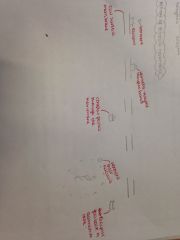
|
|
|
Action of steroid hormones
|
•hormone approaches receptor
•hormone binds to receptor and a hormone-receptor complex is formed •as the complex is lipid based, it can pass through the cell surface membrane •the hormone then enters the nucleus and directly effects the genes •the receptor then goes back to the cell surface membrane |
|
|
|
Adrenaline
|
A protein/peptide hormone
|
|
|
|
Adrenal glands
|
•secretes insulin
•has medulla and cortex region •most cells of the body have adrenaline receptors •prepares the body for activity |
|
|
|
Endocrine
|
•release hormone directly into the blood
•ductless gland E.g. Pancreas releases insulin into the blod |
|
|
|
Adrenal medullla
|
•found in the centre of the adrenal gland
•manufactures and releases adrenaline |
|
|
|
Adrenal cortex
|
•use cholesterol to produce certain steroid hormones
E.g. •mineralocorticoids to help control concentrations of Na+ and K+ •glucocorticoids to help control the metabolism of carbohydrates and proteins in the liver |
|
|
|
Pancreas
|
•consists of pockets of tissue called islets of langerhans
•endocrine and exocrine functions •beta cells manufacture and secrets insulin •alpha cells manufacture and secrete glucagon |
|
|
|
Control of blood glucose
|
INSULIN
Stimulus-rise in blood glucose Receptor and effector- beta cells in islets of Langerhans •Beta cells secrete insulin and alpha cells stop secreting glucagon •insulin is secreted directly into the blood and glycoproteins on the cell surface membrane of cells act as receptors •this increases the cells permeability to glucose and thus decreases blood glucose by: 1. Increased conversion of glucose to glycogen (glycogenesis) 2. Increases conversion of respiration 3. Increased conversion of glucose to fats 4. Increase absorption of glucose through specific channels |
|
|
|
Exocrine
|
•transport hormones to the site of action in special ducts
E.g. Pancreatic juice to intestines |
|
|
|
Action of protein/peptide hormones
|
•Hormone (1st messenger) approaches receptor site
•Hormone binds to receptor on cell surface membrane to form a hormone-receptor complex •this activates the inactive adenyl cyclase •adenyl cyclase causes ATP to go to cAMP. The concentration of cAMP in the cell increases •cAMP (2nd messenger) activates the inactive enzymes in the cell •this alters the metabolism of the cell |
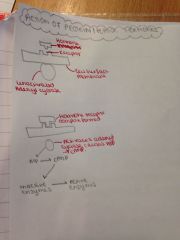
|
|
|
Action of steroid hormones
|
•hormone approaches receptor
•hormone binds to receptor and a hormone-receptor complex is formed •as the complex is lipid based, it can pass through the cell surface membrane •the hormone then enters the nucleus and directly effects the genes •the receptor then goes back to the cell surface membrane |
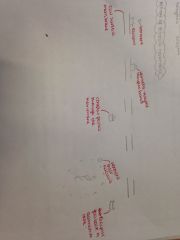
|
|
|
Protein/peptide hormones
|
•derivatives of amino acids
•not soluble in the phospholipid bilayer •doesn't enter the cell E.g. Adrenaline and insulin |
|
|
|
Steroid hormones
|
•soluble in the phospholipid bilayer
•passes through bilayer and enters the cell •has a direct effect on the DNA nucleus of cell E.g. Sex hormones |
|
|
|
Action of protein/peptide hormones
|
•Hormone (1st messenger) approaches receptor site
•Hormone binds to receptor on cell surface membrane to form a hormone-receptor complex •this activates the inactive adenyl cyclase •adenyl cyclase causes ATP to go to cAMP. The concentration of cAMP in the cell increases •cAMP (2nd messenger) activates the inactive enzymes in the cell •this alters the metabolism of the cell |
|
|
|
Action of steroid hormones
|
•hormone approaches receptor
•hormone binds to receptor and a hormone-receptor complex is formed •as the complex is lipid based, it can pass through the cell surface membrane •the hormone then enters the nucleus and directly effects the genes •the receptor then goes back to the cell surface membrane |
|
|
|
Adrenaline
|
A protein/peptide hormone
|
|
|
|
Adrenal glands
|
•secretes insulin
•has medulla and cortex region •most cells of the body have adrenaline receptors •prepares the body for activity |
|
|
|
Control of blood glucose
|
GLUCAGON
Stimulus- drop in blood glucose Receptor and effector- alpha cells in the islets of Langerhans •alpha cells secrete glucagon and beta cells stop secreting insulin •glucagon secreted into the blood •only hepatocytes have glucagon receptors •increases blood glucose by: 1. Glycogen to glucose (glycogenolysis) 2. More fatty acids are used in respiration 3. Production of glucose from amino acids and fats (gluconeogenesis) |
|
|
|
Normal blood glucose concenyration
|
90mg 100cm3
|
|
|
|
Control of insulin secretion
|
•cell membrane of beta cells contain both k+ and ca2+ channels
•when k+ channels open= k+ diffuses out •this leaves inside of cell electrically negative ( rest, the potential difference across the membrane is -70 mV) •ca 2+ channels shut Vesicles containing insulin are waiting •when blood glucose concentration is high, glucose moves into the cell •glucose goes to glucose phosphate by glucokinase •glucose is metabolised to produce ATP •ATP is used to shut k+channels •accumulation of k+ inside the cell causes the cell to became electrically positive •the change in potential difference causes ca2+ to open Ca2+ enters the cell and cause the vesicles containing insulin to fuse with the cell membrane releasing insulin by exocytosis |
|
|
|
Diabetes
|
A condition where the body is unable to control its blood glucose concentration effectively
|
|
|
|
Type I diabetes- "insulin dependent diabetes"
|
•often develops in childhood
•autoimmune response, where the body's own immune system attacks and destroys beta cells •body is unable to manufacture or store sufficient insulin •treated with insulin injections •regular exercise •new method- transplantation of islets of Langerhans |
|
|
|
Type II diabetes- "non insulin dependent diabetes"
|
•body can still produce insulin, but body's responsiveness to insulin declines- receptors on the liver and muscles cells decline so lose their ability to respond to insulin
• risk factors: obesity, diet, age, family history, people from Afro-Caribbean descent •treatment is initially lifestyles changes- changing diet, losing weight, regular exercise) •if unsuccessful it may be supplemented with insulin injections or tablets which slow the absorption of glucose |
|
|
|
Genetic engineering of glucose
|
•Plasmid removed from bacterium
•Restriction enzyme used to open plasmid •Enzyme used to cut gene for insulin production from chromosome •Genetically altered plasmid is placed in new bacterium •Bacterium begins to divide and multiply •Each bacteria now produces insulin •Insulin must now be separated from bacterium |
|
|
|
Advantages of genetic engineering of glucose
|
•Less moral and religion objections
•Cheaper to manufacture insulin than to extract from animals •Supply can match demand •lower infection risk •less chance of rejection as it is an exact copy of human insulin |
|
|
|
Motor neurones
|

•connected to muscle fibres and glands
|
|
|
|
Sensory neurones
|

•Connected to a sensory receptors which carries impulse to central nervous system
|
|
|
|
Relay neurone
|

•connect sensory neurones to motor neurones
|
|
|
|
Features of neurone cells
|
•long- transmit over long distance
•myelin sheath- insulates neurones •plasma membrane contains k+, na+ and ca2+ voltage gated channels to control their entry •contain mitochondria for ATP in cell body •maintain potential difference across cell surface membrane |
|
|
|
1. Generating an action potential
|

RESTING POTENTIAL
•Membrane is polarised •Potential difference across membrane= -60 mV •Na/K pump •3 Na out for 2 K in •Leaves inside of cell negative •Large inorganic ions also leave inside of cell negative |
|
|
|
2. Generating an action potential
|

•voltage gated channels open due to voltage change in preceding section of axon
•Na+ moves into cell down their concentration gradient |
|
|
|
3. Generating an action potential
|

•Move voltage gated Na+ channels open
•INFLUX of Na+ into cell |
|
|
|
4. Generating an action potential
|

ACTION POTENTIAL
•As more Na+ flow into cell, it becomes more positively charged •Voltage gated Na+ channels close and become inactive THE MEMBRANE IS DEPOLARISED •Due to absolute refractory periods, no new resting potential can be sent and propagates the action potential in one direction |
|
|
|
5. Generating an action potential
|

•K+ wants to move out of cell chemically and electrically due to movement of Na+
•k+ channels open •K+ EFFLUX out of the cell THE MEMBRANE IS REPOLARISED. Sometimes the repolarisation can overshoot= hyperpolarised |
|
|
|
6. Generating an action potential
|

•All voltage gated channels close
•Cell returns to resting potential due to action of na/k pump •voltage gated Na+ channels closed by active= a new resting potential can be sent |
|
|
|
Generator potential
|
•An action potential is an all or nothing response
•Once a generator potential is generated, if the threshold level is exceeded then an action potential will be sent •An action potential always produces the same depolarisation of -40mV |
|
|
|
Myelinated neurones
|

THIS IS SALTATORY CONDUCTION
•Local currents are elongated •action potential jumps from node to node, as the Na and k cannot diffuse through the myelin sheath. Na+ channels are located at the nodes •Faster transmission |
|
|
|
Non-myelinated neurones
|

•When an action potential occurs, the Na+ channels open a particular point along the neurone
•This causes an influx of Na into the cell •The leaves inside of positive and membrane is depolarised •Na+ diffused sideways away from positively charged region as opposites attract •this movement creates a localised circuit •If an action potential is generated the Na+ channels close and the k+ channels open, repolarising the membrane •The neurone returns to resting potential and only now can a new stimulus be received |
|
|
|
Pacinian corpuscles
|
•Receptor potential (convert energy of stimulus into receptor potential)
•Transducers (energy of stimulus is converted to electrical energy) •Mechanoreceptors •stimulus is pressure 1. Pressure is stimulus 2. Deformation (change of shape) causes the Na+ channels to open 3. This creates a localised circuit 4. Leads to a generator potential 5. If threshold level is exceeded then a generator potential will be sent |
|
|
|
What speeds up propagation?
|
1. Schwann cell (made of myelin)
2. Wide axon diameter- as it increases the ratio of membrane to axoplasm so there is less resistance to the flow of charges |
|
|
|
Frequency of transmission
|
•when the stimulus is at a higher intensity, the sensory receptor will generate more generator potentials
•this will cause more action potentials to be sent |
|
|
|
Why synapses?
|
1. Unidirectional- ensure information is only sent in one direction
2. Convergence- allows integration of multiple inputs 3. Divergence- allows information to be sent to several areas at once 4. Filter out low stimuli- lost at synapse of threshold isn't reached 5. Summation- low level signals are amplified: •Spatial summation- several pre synaptic terminals at one junction •Temporal summation- one pre-synaptic terminal releasing lots of neurotransmitter over a short period •Acclimatisation- repeated stimulsation over a short period fatigues synapse. Neurotransmitter can't be replaced fast enough so we stop responding •Modulation- the plasticity of synapses; ability to remodel, strengthen or weaken a synapse |
|
|
|
Cholingeric synapse
|
A synapse that uses acetylcholine as a neurotransmitter
|
|
|
|
Cholingeric synapse
|
A synapse that uses acetylcholine as a neurotransmitter
|
|
|
|
Presynaptic neurone (synaptic knob)
|
•Mitochondria for ATP
•Endoplasmic reticulum •Vesicles containing neurotransmitter Voltage gated ca2+ channels in membrane |
|
|
|
Post synaptic membrane
|
•Membrane contains voltage gated Na channels
•channels have acetylcholine receptors. Receptors are complementary in shape to acetylcholine •When acetylcholine binds to receptors, the Na channels open |
|
|
|
Transmission across the synapse
|
•Action potential arrives at presynaptic neurone
•this causes ca2+ channels in membrane to open and ca2+ to diffuse into the neurone •This causes the vesicles containing acetylcholine to move to pre synaptic membrane and fuse with it •acetylcholine is released by exocytosis •acetylcholine diffuses across synaptic cleft •binds to receptors on Na channels in post synaptic membrane •this causes Na to diffuse across the post synaptic membrane and into the post synaptic neurone •this generates an a generator potential •if sufficient generator potentials combine the potential across the neurone reaches threshold level •A new action potential is then generated in the post synaptic neurone |
|
|
|
Energy
|
Exists as potential or kinetic energy
|
|
|
|
Uses of energy in humans
|
•DNA replication
•active transport •movement of vesicles and microtubules •synthesis of large molecules from small ones |
|
|
|
Energy
|
Exists as potential or kinetic energy
|
|
|
|
Uses of energy in humans
|
•DNA replication
•active transport •movement of vesicles and microtubules •synthesis of large molecules from small ones |
|
|
|
Resporation
|
A process by which energy stored in complex organic molecules is used to make ATP. It is a gradual process
|
|
|
|
Energy
|
Exists as potential or kinetic energy
|
|
|
|
Uses of energy in humans
|
•DNA replication
•active transport •movement of vesicles and microtubules •synthesis of large molecules from small ones |
|
|
|
Respiration
|
A process by which energy stored in complex organic molecules is used to make ATP. It is a gradual process
|
|
|
|
Why is ATP the 'universal currency' of cells?
|
•Can be transported around the cell as it is small and water soluble
•It is used by every organism •Provides a gradual release of energy •Allows anabolic and catabolic reactions to occur simultaneously •It can be broken down and delivered to cells to provide an immediate use of energy |
|
|
|
What does ATP look like?
|
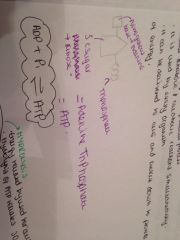
|
|
|
|
Mitochondria ultrastructure
|
MATRIX (link reaction and Krebs cycle)
•Molecules if NAD •Enzymes catalyse these reactions •Mitochondria DNA codes for proteins and enzymes •Mitochondria ribosomes where proteins are assembled OUTER MEMBRANE: •Phospholipid bilayer •contains proteins which form channels and carriers which allow the movement of molecules e.g. Pyruvate INNER MEMBRANE: • Different compostion- impermeable to small ions •Contains folded cristae to provide a large surface area •Embedded in cristae is electron carriers and ATP synthase enzymes |
|
|
|
Glycolysis
|
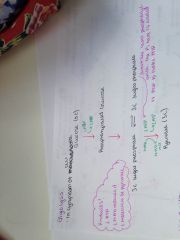
Occurs in cytoplasm of cell
|
|
|
|
Link reaction
|
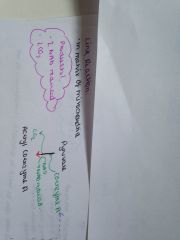
•Occurs in matrix of mitochondria
|
|
|
|
Mitochondria ultrastructure
|
MATRIX (link reaction and Krebs cycle)
•Molecules if NAD •Enzymes catalyse these reactions •Mitochondria DNA codes for proteins and enzymes •Mitochondria ribosomes where proteins are assembled OUTER MEMBRANE: •Phospholipid bilayer •contains proteins which form channels and carriers which allow the movement of molecules e.g. Pyruvate INNER MEMBRANE: • Different compostion- impermeable to small ions •Contains folded cristae to provide a large surface area •Embedded in cristae is electron carriers and ATP synthase enzymes |
|
|
|
Glycolysis
|
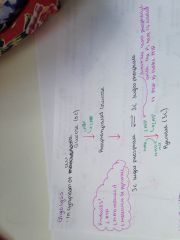
Occurs in cytoplasm of cell
|
|
|
|
Link reaction
|

•Occurs in matrix of mitochondria
|
|
|
|
Krebs cycle
|
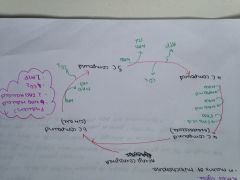
•Occurs in the matrix of mitochondria
|
|
|
|
Oxidative phosphorylation
|
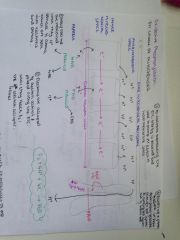
•Occurs on cristae of mitochondria
|
|
|
|
ATP- theoretical vs. actual
|
The full 30 molecules of ATP that could be produced from one molecule of glucose rarely happens because:
•ATP is used for active transport of pyruvate into mitochondria •ATP used to transport reduced NAD from glycolysis in cytoplasm into the mitochondria •some protons leak across mitocondrial membrane so reducing the number of protons to turn ATP synthase and produce ATP |
|
|
|
Evidence for chemiosmosis
|
•Lower pH in inter membrane space
•Move -ve potential on matrix side of ETC •When stalks removed from cristae, no ATP is produced •No ATP is made in mioblasts (mitochondria with no inter membrane space) |
|
|
|
Respiratory substrate
|
•An organic molecule that can be used for respiration
•The more hydrogen contained in a molecule the more ATP that can be generated when the substrate is respired |
|
|
|
Carbohydrate as a respiratory substrate
|
•Glucose is the main substrate and in some mammalian cells, glucose can only be used for respiration
•other monosaccharides are changed to glucose for respiration •glucose is about 30% efficient, remaining energy is lost as heat which helps to maintain a suitable body temperature •maximum energy yield for glucose is 2870 KJ mol-1 |
|
|
|
Protein as a respiratory substrate
|
•Excess amino acids, released after protein digestion may be deaminated
•the rest of the molecule is changed to glycogen or fat where it is stored and later respired as energy •during starvation protein from muscle can be hydrolysed to amino acids •some can be converted to pyruvate and carried to Krebs cycle •The number of h atoms per mole accepted by NAD is slightly more that the number of h atoms per mole of glucose so the proteins release slightly more energetic than the equivalent masses of carbohydrate |
|
|
|
Anaerobic respiration
|
•In absence of 02 the ETC cannot function so the link and Krebs cycle stop
•NAD reduced is reoxidised so that glycolysis can still occur •Some ATP is produced |
|
|
|
Lactate fermentation
|
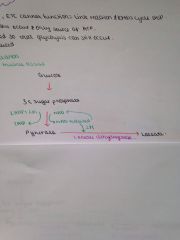
•in mammalian muscle tissue
|
|
|
|
Alcoholic fermentation
|

•In fungal cells e.g. Yeast
•in waterlogged soils |
|
|
|
Respiratory substarte
|
An organic molecule that can be used for respiration
|
|
|
|
Respiratory substrates
|
•the more hydrogen contained in a molecule, the more oxidative phosphorylation that can occur
•fatty acids=long chained hydrocarbons=lots of ATP •glucose is only 30% efficient, some energy if lost as heat energy |
|
|
|
Respiratory substarte
|
An organic molecule that can be used for respiration
|
|
|
|
Respiratory substrates
|
•the more hydrogen contained in a molecule, the more oxidative phosphorylation that can occur
•fatty acids=long chained hydrocarbons=lots of ATP •glucose is only 30% efficient, some energy if lost as heat energy |
|
|
|
Lipids as a respiratory substrate
|

•lipid would only be used as a substrate as glucose runs out
•protein would be used as a substrate as a last resort |
|
|
|
Mean values per gram of substrate
|
Carbohydrate=15.8 kJg-1
Lipid=39.4 kJg-1 Protein= 17.0 kJg-1 |
|
|
|
Respiratory quotient
|
Ratio of CO2 given out to the volume of 02 consumed in the same time
RQ= RC/R0 |
|
|
|
How is the respiratory quotient calculated?
|
•from a balanced equation
E.g. C6H1206 + 602 goes to 6C02 + 6H20 RQ= 6/6 = 1 |
|
|
|
Respirator quotient vaules
|
Carbohydrate=1
Lipid= 0.9 (<1) Protein= 0.7 (<1) Anaerobic respiration= <1 |
|
|
|
Autotrophs
|
Organisms that use simple inorganic molecules e.g. C02 to synthesise complex organic molecules e.g. Glucose
|
|
|
|
Autotrophs
|
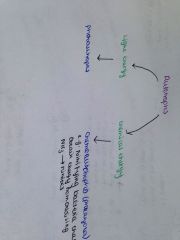
|
|
|
|
Heterotrophs go
|
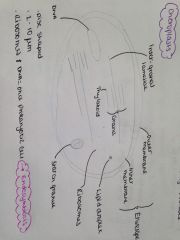
Organisms that are able to feed on, digest or absorb complex organic molecules and release the chemical potential within them
|
|
|
|
Chloroplasts
|
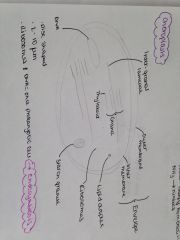
•Disco shaped
•2-10 um •ribosomes and DNA= once prokaryotic cells- ENDOSYMBIOSIS |
|
|
|
Adaptations of chloroplastz
|
•Inner membrane contains transport proteins which control the entrance and exit of substances from the stroma to the cytoplasm
•many grana provide a large surface for photosynthetic pigments •photosynthetic pigments arranged in photo systems for maximum absorption of light •stroma contains fluid to catalyse the reactions of light dependent stage •grana surrounded by stroma so that the products from the light dependent stage that are required in the light independent stage can pass from the stroma to the thylakoid membrane |
|
|
|
Primary pigment
|
Act as a reaction centre for photosystem e.g. Chloroplasts a
|
|
|
|
Primary pigment
|
Act as a reaction centre for photosystem e.g. Chlorophyll a
|
|
|
|
Accessory pigment
|
Surround primary pigment and absorb wavelengths of light not absorbed by them. It then passes the energy to the primary pigment e.g. Chlorophyll b and cartenoids
|
|
|
|
Light dependent stage
|
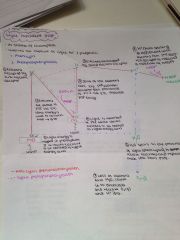
•In the thylakoid membrane
•Involves the capture of light for: 1. Photolysis 2. Photophosphorylation |
|
|
|
Light independent stage/Calvin Cycle
|
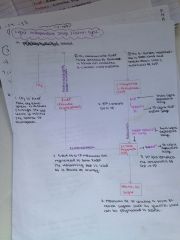
•In stroma of chloroplast
|
|

